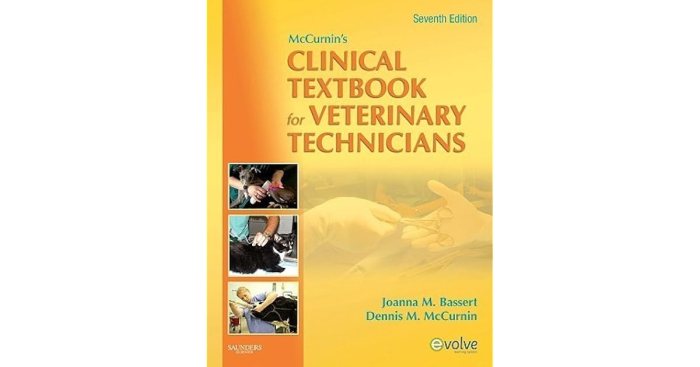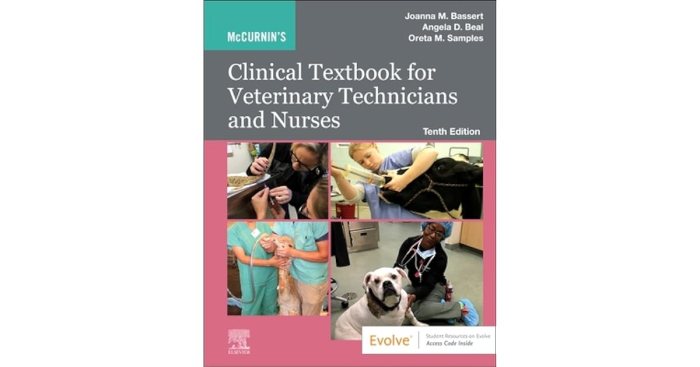McCurnin’s Clinical Textbook for Veterinary Technicians and Nurses stands as an authoritative and indispensable resource, providing a comprehensive foundation for veterinary professionals. This meticulously crafted textbook empowers veterinary technicians and nurses with the knowledge and skills essential for delivering exceptional patient care.
With its clear organization, engaging case studies, and practical applications, McCurnin’s Clinical Textbook is a valuable asset for students and practicing professionals alike. Its comprehensive coverage of veterinary procedures, diagnostics, and therapeutic interventions ensures that readers are well-equipped to meet the challenges of modern veterinary practice.
1. Overview of McCurnin’s Clinical Textbook for Veterinary Technicians and Nurses
McCurnin’s Clinical Textbook for Veterinary Technicians and Nurses is a comprehensive and authoritative textbook designed to provide veterinary technicians and nurses with the essential knowledge and skills required for their professional practice.
The book is written by a team of experienced veterinary professionals and educators, and it covers a wide range of topics, including veterinary anatomy and physiology, pharmacology, nursing care, and diagnostic and treatment procedures.
The target audience for this textbook is veterinary technicians and nurses who are currently enrolled in or have recently completed a veterinary technology or nursing program.
2. Content Organization and Structure

The textbook is organized into 14 chapters, each of which covers a different topic in veterinary medicine.
The chapters are arranged in a logical sequence, starting with the basics of veterinary anatomy and physiology and progressing to more advanced topics such as pharmacology and nursing care.
Each chapter is divided into several sections, each of which covers a specific aspect of the topic.
3. Key Features of the Textbook
One of the key features of McCurnin’s Clinical Textbook for Veterinary Technicians and Nurses is its strong focus on clinical practice.
The book includes a wealth of case studies and examples that illustrate how the information presented in the text can be applied to real-world situations.
Another key feature of the textbook is its comprehensive coverage of veterinary pharmacology.
The book includes a detailed discussion of the different classes of drugs used in veterinary medicine, as well as their indications, dosages, and side effects.
4. Case Studies and Examples
The case studies and examples included in McCurnin’s Clinical Textbook for Veterinary Technicians and Nurses are one of the book’s most valuable features.
These case studies and examples help students to learn how to apply the information presented in the text to real-world situations.
The case studies and examples are also a great way for students to test their understanding of the material.
5. Pedagogical Features

McCurnin’s Clinical Textbook for Veterinary Technicians and Nurses includes a number of pedagogical features that are designed to help students learn.
These features include learning objectives, chapter summaries, and review questions.
The learning objectives at the beginning of each chapter help students to focus their studying.
The chapter summaries at the end of each chapter provide a concise overview of the material covered in the chapter.
The review questions at the end of each chapter help students to assess their understanding of the material.
6. Comparison with Other Textbooks
McCurnin’s Clinical Textbook for Veterinary Technicians and Nurses is one of the most popular textbooks used in veterinary technology and nursing programs.
The book is well-written and comprehensive, and it includes a wealth of case studies and examples.
However, there are a few other textbooks that are also worth considering.
One of the most popular alternatives to McCurnin’s Clinical Textbook for Veterinary Technicians and Nurses is Veterinary Nursing: A Practical Guide by Mary Fraser.
This book is also well-written and comprehensive, and it includes a number of features that are not found in McCurnin’s textbook, such as a glossary of terms and a list of abbreviations.
Another popular alternative to McCurnin’s Clinical Textbook for Veterinary Technicians and Nurses is Veterinary Technology: A Practical Guide by Kathy Bonney.
This book is also well-written and comprehensive, and it includes a number of features that are not found in McCurnin’s textbook, such as a chapter on veterinary ethics and a chapter on veterinary business management.
7. Relevance to Veterinary Practice
The information presented in McCurnin’s Clinical Textbook for Veterinary Technicians and Nurses is directly relevant to veterinary practice.
The book covers a wide range of topics that are essential for veterinary technicians and nurses to know, including veterinary anatomy and physiology, pharmacology, nursing care, and diagnostic and treatment procedures.
The book also includes a number of case studies and examples that illustrate how the information presented in the text can be applied to real-world situations.
Answers to Common Questions
What is the target audience for McCurnin’s Clinical Textbook?
McCurnin’s Clinical Textbook is primarily intended for veterinary technicians and nurses, providing them with a comprehensive foundation in veterinary medicine.
How is the textbook organized?
The textbook is organized into logical sections and chapters, covering a wide range of topics essential for veterinary practice, including anatomy, physiology, diagnostics, and therapeutic interventions.
What are the key features of the textbook?
McCurnin’s Clinical Textbook is renowned for its clear organization, engaging case studies, and practical applications, making it an invaluable resource for both students and practicing professionals.